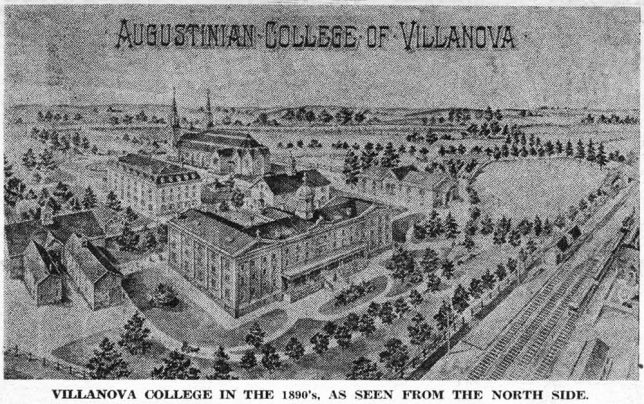 At first glance the reader may not immediately recognize the picture, shown above, as one of our nearby Villanova University. But time makes many changes, and it is at least 60 years since this picture was taken, when Villanova was only a college. It appears in “Rural Pennsylvania in the Vicinity of Philadelphia,” written by the Rev. S.F. Hotchkin and published by George W. Jacobs and Company, Philadelphia, in 1897.
At first glance the reader may not immediately recognize the picture, shown above, as one of our nearby Villanova University. But time makes many changes, and it is at least 60 years since this picture was taken, when Villanova was only a college. It appears in “Rural Pennsylvania in the Vicinity of Philadelphia,” written by the Rev. S.F. Hotchkin and published by George W. Jacobs and Company, Philadelphia, in 1897.
In his book, Mr. Hotchkin quotes from the Rev. Thomas C. Middleton, D.D., O.S.A., at that time prefect of studies and professor of moral theology, church history, canon law and homiletics in the ecclesiastical department at Villanova College:
“Slightly less than a mile west of Rosemont, with its buildings crowning a gently sloping hill, stands Villanova, the mother house in the United States of the Roman Catholic Order of religious known as Augustinians. Their first establishment in this country was made at Philadelphia towards the close of the last century when, in 1776, the Rev. Dr. Matthew Carr, a member of the Irish Province of their Order, founded the Church and Convent of St. Augustine.
“Villanova, an offshoot of this Philadelphia venture, was planted in 1842, chiefly through the agency of the Rev. John P. O’Dwyer, on the estate of the late John Rudolph, a well known Catholic merchant of Burlington, N.J., and Philadelphia, who there, at his country seat, known as ‘Belle-Air,’ set up a station, or meeting-place for the Catholics of the neighborhood when occasionally they gathered for Mass and the service of religion. This was about 1806.
“Shortly after Mr. Rudolph’s death in 1838, a large part of his property was purchased by the Augustinians, who purposed to establish there, the headquarters of their Order, in the country, a complete religious and education center, with convent, novice and study-house for their own members, and college for the instruction of the laity in classics, scientific and polite learning. Under the protection of one of the famous saints of their Order, Thomas of Villanova, Father O’Dwyer opened the convent and college at ‘Belle-Air,’ henceforth to be known as Villanova, in 1824.
“Their choice of titular saint for their institution seems appropriate, as the name Thomas recalls the holy superior of their Province of Castile in the 16th century, under whom first Augustinian missionaries to the new world founded in the City of Mexico, in 1551, the first school of learning on a large scale in America.
“At Villanova, besides the charge of the brotherhood and college, the Augustinians had care also of the Catholics as far around as ten and 15 miles. In 1843, Fr. O’Dwyer, the leading spirit of the new venture, numbered in all about a half-dozen families in his congregation. In 1844, Bishop Kenrick dedicated Villanova Chapel, and in this building divine services were held until 1872, when a frame structure, now used as college gymnasium, was erected to meet the growing needs of the faithful. A few years later in 1883, was begun the Gothic church which, with sitting room for 700 persons, seven altars, and its noble apsidal choir, gives ample scope for the accommodation of the laity, and the observance of ritual in all its fullness. Offshoots of the Villanova mission, but now independent churches, are the congregations at Berwyn, Bryn Mawr and Wayne.
“The year after the opening of the monastery in 1843, by sanction of Gregory XVI, Villanova was created a novice-house of the Order. And in this same year, the habit of religion was first given to two aspirants of the Order, one of these, Brother John, a veteran of some 85 years of age, dying in 1894. In 1843, the the college course was opened to the laity – 13 youths being enrolled on the first day – for their education in sacred and profane studies, philosophy, the classics, humanities, music, drawing and the modern languages.
“In 1848 the college was empowered by the State to ‘educate persons in the various branches of science, literature,’ etc., and ‘to confer such degrees as are granted in other colleges and universities of the United States.’ In 1849 was erected the east college hall, and in 1874 the main building – since burned down – with a frontage of 174 feet, with halls and rooms sufficient for the residence and instruction of 150 students.”
(A brief description of Villanova College as it is today, in its most recent “Bulletin” will appear in next week’s column.)
